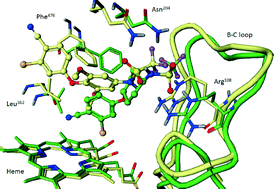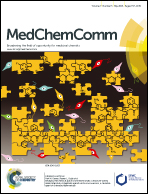Discovery of a novel binding pocket for CYP 2C9 inhibitors: crystallography, pharmacophore modelling and inhibitor SAR†
Abstract
Herein, we describe the discovery of a novel binding pocket for CYP 2C9 inhibitors. Trifluoromethanesulfonamide compounds 1 and 2, identified within a Pfizer progesterone receptor antagonist program, were found to strongly inhibit the drug metabolizing cytochrome P450 enzyme CYP 2C9. Homology modelling and subsequent X-ray co-crystal data have elucidated the binding orientation of compounds 1 and 2 in CYP 2C9. Compound 2 adopts a previously unreported binding mode. Less acidic sulfonamide analogues within these series have reduced CYP 2C9 activity, and we postulate this is due to a reduced hydrogen bonding potential with key interacting residues within CYP 2C9. This work shows that CYP 2C9 has a more flexible active site than previously reported; therefore multiple binding modes and alternative pharmacophore models must be considered when predicting CYP 2C9 affinity.

- This article is part of the themed collection: Celebrating our 2021 Prizewinners

 Please wait while we load your content...
Please wait while we load your content...